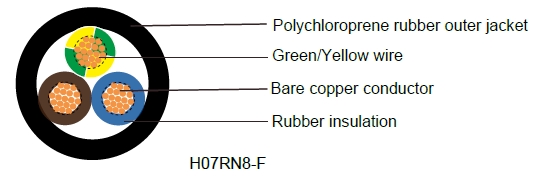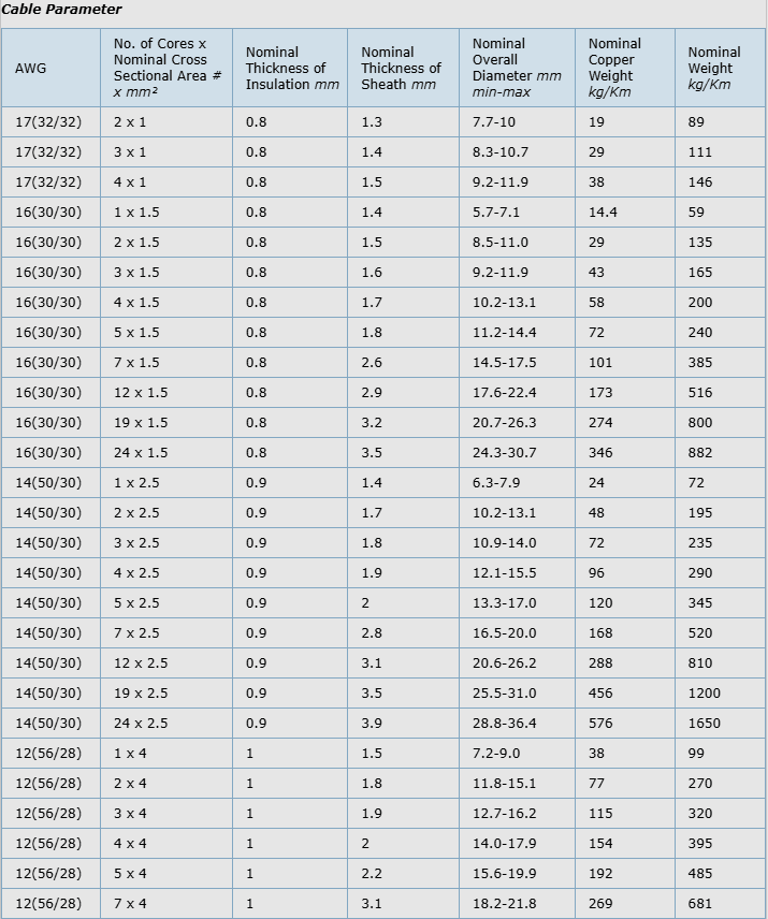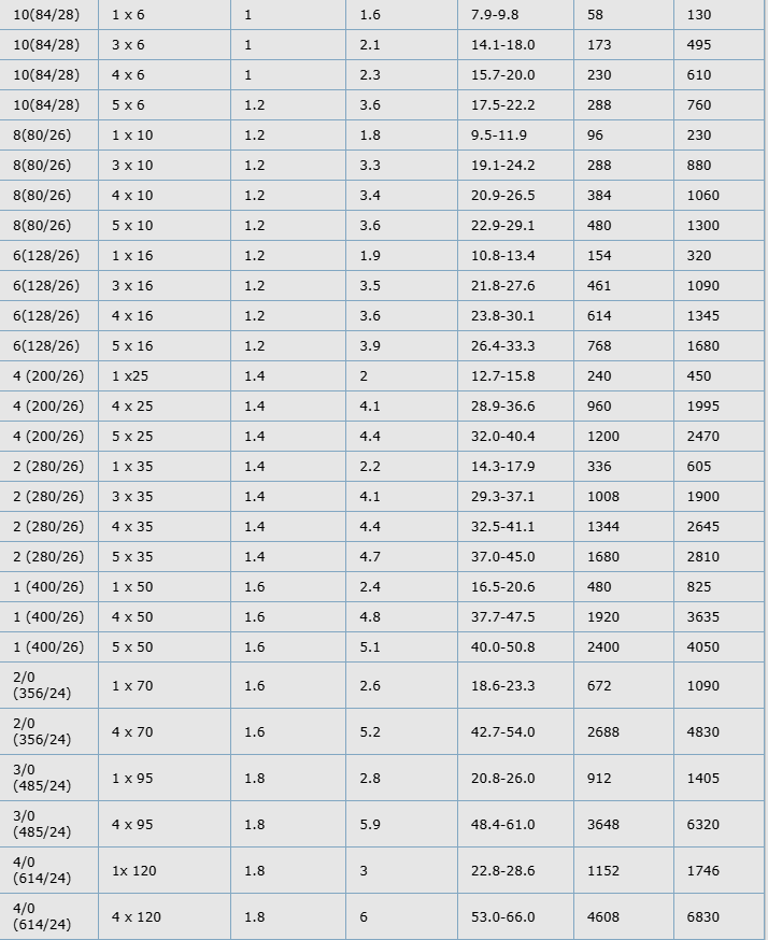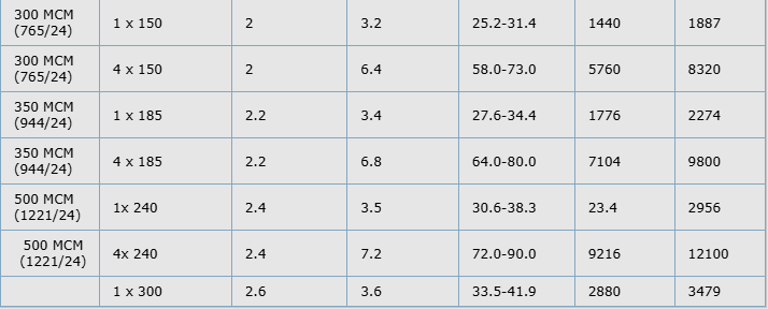Anhui Feichun Special Cable Co.,Ltd Li.wang@feichuncables.com

H07RN8-F
Application and Description
These cables particularly for use in fresh water up to 10 m depth with a maximum water temperature up to 40°C , such as the connection of submersible pumps or similar applications. Not suitable for underwater power transmission or installation in a watercourse, or where it is possible that mechanical damage might occur and cause a hazard.
Indirect underground installation is allowed provided that there is mechanically protection of the cables. These cables are manufactured according to the Standard and Approval CEI 20-19/16 (CENELEC HD 22.16).
It is the only cable that the installation Standard and Approval CEI 64-8 at section 702 allows for installation in swimming pools and fountains. For connections liable to moderate mechanical stresses, i.e. industrial or agricultural workshop apparatus, large boilers, heater plates, electric tools such as drills and disk saws, electric appliances, portable motors and generators on building sites;also for fixed installations along floors or shelving on temporary job sites, for connecting structural elements in lifting apparatus, machinery, etc.
Suitable for applications up to 1000 V for adequately protected fixed installations ( i.e. inside pipes or equipment) as well as for rotor connections to lifting apparatus motors. They are Ozone, UV & weather resistant.
Standard and Approval
CEI 20-19 p.16, CE low voltage directive 73/23/EEC & 93/68/EEC., ROHS compliant
Cable Construction
Technical Characteristics
Fine bare copper strands |
Strands to VDE-0295 Class-5, IEC 60228 Class-5 |
Rubber core insulation EI4 to VDE-0282 Part-1 |
Color code VDE-0293-308 and HD 186 |
Polychloroprene rubber (neoprene) jacket EM2 |
Working voltage | 450/750 volts |
Test voltage | 2500 volts |
Flexing bending radius | 6.0 x O |
Fixed bending radius | 4.0 x O |
Flexing Temperature | -25oC to +60oC |
Fixed Temperature | -40oC to +60oC |
Max Water Temperature | +40 oC |
Short circuit temperature | +250 oC |
Flame retardant | IEC 60332.1 |
Insulation resistance | 20 MΩ x km |



Introduction to the H07RN8-F Cable
In South Africa, where diverse industries like mining, agriculture, and construction thrive, reliable electrical cables are the backbone of operations. Enter the H07RN8-F cable—a tough, versatile, and specialised cable designed to perform in challenging environments, including underwater applications. Whether it’s powering submersible pumps in rural water systems or heavy-duty tools on construction sites, this cable is engineered to deliver consistent performance under pressure. In this article, we’ll unpack the H07RN8-F cable’s technical specifications, its wide range of applications, its advantages, and how it’s making a difference in South Africa. We’ll also answer some frequently asked questions to help you understand why this cable is a game-changer.
What is the H07RN8-F Cable?
The H07RN8-F cable is a heavy-duty, flexible, rubber-insulated cable designed for demanding environments, including submersion in fresh water up to 10 meters deep with a maximum water temperature of 40°C. Compliant with international standards like CEI 20-19/16 and CEI 64-8 (section 702), it’s the only cable approved for use in swimming pools and fountains, making it a top choice for specialised applications. Its robust construction, featuring fine bare copper strands, rubber core insulation, and a polychloroprene (neoprene) jacket, ensures durability, flexibility, and resistance to harsh conditions like ozone, UV rays, and extreme weather.
Technical Specifications
Here’s a breakdown of the H07RN8-F cable’s key technical features:
Conductor: Fine bare copper strands (VDE-0295 Class-5, IEC 60228 Class-5) for excellent conductivity and flexibility.
Insulation: Rubber core insulation (EI4 to VDE-0282 Part-1) for superior electrical safety.
Sheath: Polychloroprene rubber (neoprene) jacket (EM2) for resistance to abrasion, chemicals, and environmental stress.
Voltage: Working voltage of 450/750 volts, with a test voltage of 2500 volts.
Temperature Range: Flexing temperature from -25°C to +60°C; fixed temperature from -40°C to +60°C; max water temperature of +40°C.
Bending Radius: 6.0 x outer diameter (flexing), 4.0 x outer diameter (fixed).
Short Circuit Temperature: Up to +250°C.
Flame Retardant: Complies with IEC 60332.1.
Insulation Resistance: 20 MΩ x km.
Standards and Approvals: CEI 20-19 p.16, CE low voltage directive 73/23/EEC & 93/68/EEC, RoHS compliant.
The cable comes in various configurations, from 1 to 24 cores, with cross-sectional areas ranging from 1 mm² to 300 mm², catering to diverse power needs. For example, a 4 x 25 mm² cable has a nominal overall diameter of 28.9–36.6 mm, a copper weight of 960 kg/km, and a total weight of 1995 kg/km, making it suitable for heavy-duty applications.
Applications of the H07RN8-F Cable
The H07RN8-F cable’s versatility makes it indispensable across South Africa’s industrial, agricultural, and commercial sectors. Its primary applications include:
Submersible Pumps: Ideal for connecting submersible pumps in fresh water up to 10 meters deep, such as in boreholes or water treatment plants. In South Africa, where water scarcity is a concern, these cables are critical for rural irrigation systems and municipal water supply projects.
Industrial and Agricultural Tools: Suitable for powering heavy-duty equipment like drills, disk saws, portable motors, and generators on construction sites, farms, or industrial workshops. Its flexibility and resistance to mechanical stress make it perfect for dynamic environments.
Swimming Pools and Fountains: As the only cable approved by CEI 64-8 for such installations, it’s used in public and private aquatic facilities across South Africa, ensuring safe and reliable power delivery.
Fixed Installations: When adequately protected (e.g., inside pipes or equipment), the cable supports fixed installations up to 1000 V, such as in lifting apparatus or machinery.
Temporary Job Sites: Its durability and flexibility make it ideal for temporary setups, like construction sites or events, where cables run along floors or shelving.
Advantages of the H07RN8-F Cable
The H07RN8-F cable stands out for several reasons, making it a preferred choice in South Africa’s rugged environments:
Durability: The neoprene jacket and rubber insulation protect against abrasion, chemicals, ozone, UV rays, and extreme weather, ensuring a long lifespan even in harsh conditions.
Flexibility: With a bending radius of 6.0 x outer diameter for flexing applications, it’s easy to install in dynamic setups like construction sites or agricultural machinery.
Water Resistance: Designed for submersion in fresh water up to 10 meters, it’s perfect for borehole pumps and aquatic installations.
Safety: Compliance with stringent standards (CEI, RoHS) and flame-retardant properties ensure safe operation in high-risk environments.
Versatility: Suitable for both temporary and fixed installations, from low-power tools to high-voltage machinery, up to 1000 V when protected.
South African Relevance: Its ability to handle extreme temperatures (-40°C to +60°C) and resist environmental stress makes it ideal for the country’s diverse climates, from the humid coastlines of KwaZulu-Natal to the dry interiors of the Karoo.
Frequently Asked Questions (FAQs)
Q: Can the H07RN8-F cable be used in saltwater environments?
A: No, it’s designed for fresh water up to 10 meters deep with a maximum temperature of 40°C. Saltwater or watercourses with potential mechanical damage are not suitable.
Q: Is this cable suitable for underground installation?
A: Yes, but only with mechanical protection, such as conduits, to prevent damage.
Q: What makes the H07RN8-F cable safe for swimming pools?
A: It’s the only cable approved by CEI 64-8 for swimming pools and fountains due to its robust insulation and water-resistant neoprene jacket, ensuring safety in wet environments.
Q: Can it handle South Africa’s extreme weather?
A: Absolutely. Its ozone, UV, and weather resistance, combined with a temperature range of -40°C to +60°C, makes it ideal for South Africa’s varied climates.
Q: What’s the difference between flexing and fixed bending radius?
A: The flexing bending radius (6.0 x outer diameter) applies to dynamic applications where the cable moves, while the fixed bending radius (4.0 x outer diameter) is for stationary installations.

Email Address: Li.wang@feichuncables.com
© 2025. All rights reserved.


One-click to Quickly Contact
Products
Offshore & Marine Cable
XLPE Cable
Contact
Company
Location:
Building A Private Science and Technology Park, Hefei Economic and Technological Development Zone, Anhui Province, China
